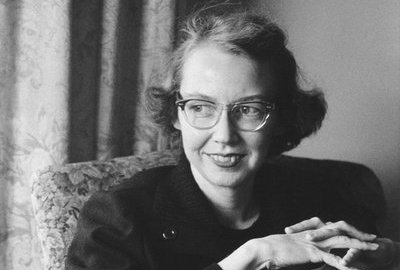What?! It’s over! Fun With Flannery is finished?? NO! Rats! Dang. Phooey. Sadness… sigh.

But what an amazing week of discovery it was, led by Dr. Karen Swallow Prior. A teacher I know frequently warns his students, “Don’t miss your moment!” This workshop was certainly the moment to experience an immersion into Flannery O’Connor – her writing style, her art and her calling.
The larger context of the Fun With Flannery class is The Glen Workshop – a marvelous week long art-and-faith event which seems to defy everyone’s attempts at describing it. I like the paragraph on the landing page of The Glen’s website:
“Situated in the foothills of the Sangre de Cristo Mountains [in Santa Fe, New Mexico], the Glen Workshop is equal parts creative workshop, arts festival, and spiritual retreat. The Glen’s arresting natural environment is contrasted by its casual and inviting crowd of artists, writers, musicians, art appreciators, and spiritual wayfarers of all stripes.”
If as an artist you are dry as dust, this gathering of kindred souls in the High Desert location of St John’s College, where The Glen takes place, will drench you in beauty, friendship and inspiration. The Glen Worksop is sponsored by Image Journal which is out of Seattle Pacific University,
But back to Flannery O’Connor. All thirteen of us Glensters agreed that the most surprising discovery of the workshop was the power of reading O’Connor’s stories aloud. As we listened to a story, often read in long sections, Flannery’s uncanny insight into the human heart became more illuminating, more comical, more touching, more shocking.
In addition, each short story video Dr. Prior presented gave us a new picture of a Flannery story, illustrating how wondrously visual she is in her writing. Color, setting, sunlight, shadows, symbols — all play a part in an O’Connor short story. “Flannery has a purpose for everything she puts in her stories, ” said Dr. Prior, “Nothing is extra, nothing is wasted.”
What about the violence contained in O’Connor’s stories? It wasn’t long before the class could see the paradox that Dr. Prior suggested was in Flannery’s work: Violence was a means of grace for her characters. Violence was O’Connor’s method to force her figures to shake-off the blinders of the skewed moral judgments and cliched thinking that plagued them. As we students progressed through nine short stories together, we found that the lens we used to study Flannery’s tales transfigured itself into a mirror which reflected back to us our own flawed judgments and prejudices. One commentator in the documentary we watched on Flannery’s life, called Uncommon Grace (2015), said that O’Connor was “continuing Jesus’ work by telling parables to the modern world.” After spending a week deep-diving into Flannery O’Connor’s life and art, I believe she was indeed a parable teller of extraordinary skill.
Flannery O’Connor died in 1964 at age thirty-nine from lupus, an autoimmune disease. At that time, according to Wikipedia, Flannery’s oeuvre included two novels, three short story collections, and five other works. An addition to her work, a prayer journal, was published in 2013. I am hopeful that more of Flannery’s work will be published in the future.


